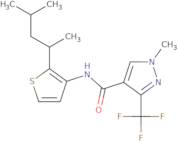Penthiopyrad
CAS: 183675-82-3
Ref. 3D-FP28793
| 1g | Discontinued | ||
| 50mg | Discontinued | ||
| 100mg | Discontinued | ||
| 250mg | Discontinued | ||
| 500mg | Discontinued |
Product Information
- N-(2-(1,3-Dimethylbutyl)-3-thienyl)-1-methyl-3-(trifluoromethyl)-1h-pyrazole-4-carboxamide
- 1-methyl-N-[2-(4-methylpentan-2-yl)thiophen-3-yl]-3-(trifluoromethyl)
- 1-methyl-N-[2-(4-methylpentan-2-yl)thiophen-3-yl]-3-(trifluoromethyl)-1H-pyrazole-4-carboxamide
- 1H-Pyrazole-4-carboxamide, N-[2-(1,3-dimethylbutyl)-3-thienyl]-1-methyl-3-(trifluoromethyl)-
- Dpx-Lem 17
- Fontelis
- Mtf 753
- N-[2-(1,3-Dimethylbutyl)-3-thienyl]-1-methyl-3-(trifluoromethyl)-1H-pyrazole-4-carboxamide
- Vertisan
- pyrazole-4-carboxamide
- See more synonyms
- 1-methyl-N-[2-(4-methylpentan-2-yl)thiophen-3-yl]-3-(trifluoromethyl)
- pyrazole-4-carboxamide
Penthiopyrad is a fungicide that belongs to the class of prothioconazole. It is used in agricultural and industrial applications as a synergist, which enhances the efficacy of other pesticides. Penthiopyrad inhibits the synthesis of ergosterol, an important component of fungal cell membranes, by inhibiting cytochrome P450 enzyme activity in the 14-alpha demethylase pathway. It also has a strong chlorine atom binding affinity and can be used to remove chlorinated hydrocarbons from water. Chronic exposure to penthiopyrad has been shown to cause specific antibodies in mice and rabbits, which have been used for drug screening and immunoassays. The biological properties of penthiopyrad are due primarily to its ability to inhibit fatty acid synthesis. Penthiopyrad is readily absorbed through skin contact or inhalation and accumulates in adipose tissue.





